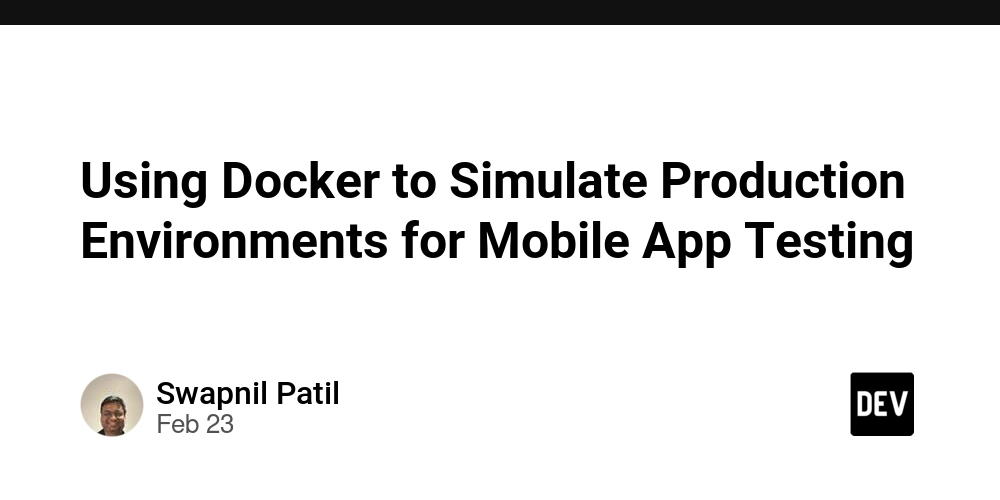Using Docker to Simulate Production Environments for Mobile App Testing
Introduction Testing mobile apps in a production-like environment is crucial to detect issues before deployment. However, setting up such environments manually can be complex and time-consuming. Docker simplifies this process by enabling developers to create isolated, reproducible, and scalable test environments that mimic real-world production setups. In this article, we’ll explore how Docker can be used to simulate a production environment for mobile app testing, including setting up backend APIs, databases, and third-party services in containers. Why Use Docker for Mobile App Testing? ✅ Consistency – Ensure uniform environments across dev, test, and production. ✅ Scalability – Simulate different load conditions with multiple containers. ✅ Dependency Management – Test apps with real backend APIs, databases, and caching systems. ✅ Automated Testing – Integrate with CI/CD pipelines for seamless testing. ✅ Faster Setup – Spin up complex environments in seconds with Docker Compose. Setting Up a Production-Like Environment with Docker A typical mobile app relies on: A backend API (Node.js, Python, etc.) A database (PostgreSQL, MySQL) A caching layer (Redis) An authentication service (OAuth, Firebase) We will containerize these components and run them locally using Docker Compose for testing. Step 1: Install Docker Download and install Docker Desktop from Docker’s official website. Verify installation: docker --version Step 2: Create a Sample Backend API (Node.js) We’ll create a simple Express.js API that connects to a PostgreSQL database and uses Redis for caching. Project Structure mobile-app-test-env/ │── backend/ │ ├── server.js │ ├── package.json │ ├── Dockerfile │── docker-compose.yml server.js (Backend API) const express = require("express"); const redis = require("redis"); const { Pool } = require("pg"); const app = express(); const port = process.env.PORT || 3000; // PostgreSQL Database Connection const pool = new Pool({ user: "user", host: "db", database: "testdb", password: "password", port: 5432, }); // Redis Cache Connection const redisClient = redis.createClient({ host: "redis", port: 6379 }); app.get("/", async (req, res) => { try { const { rows } = await pool.query("SELECT NOW()"); redisClient.set("lastRequest", new Date().toISOString()); res.json({ message: "Production-like API Running!", dbTime: rows[0] }); } catch (error) { res.status(500).json({ error: error.message }); } }); app.listen(port, () => { console.log(`Server running on port ${port}`); }); Step 3: Create a Dockerfile for the API # Use Node.js base image FROM node:14 # Set working directory WORKDIR /app # Copy package files and install dependencies COPY package.json ./ RUN npm install # Copy app source code COPY . . # Expose the API port EXPOSE 3000 # Start the API CMD ["node", "server.js"] Step 4: Define the Complete Environment in Docker Compose Create a docker-compose.yml file to orchestrate the backend API, PostgreSQL database, and Redis cache. version: "3.8" services: backend: build: ./backend ports: - "3000:3000" depends_on: - db - redis environment: DATABASE_URL: "postgres://user:password@db:5432/testdb" db: image: postgres:latest environment: POSTGRES_USER: user POSTGRES_PASSWORD: password POSTGRES_DB: testdb ports: - "5432:5432" redis: image: redis:latest ports: - "6379:6379" Step 5: Run the Simulated Production Environment Start all services with Docker Compose: docker-compose up --build Now, your backend API, database, and cache are running in isolated containers, replicating a production environment locally. Testing Mobile App Integration with Postman Once your backend is running in Docker, you can: ✅ Use Postman to send requests to http://localhost:3000. ✅ Simulate network latency by adding tc (traffic control) rules. ✅ Perform load testing using tools like k6 or JMeter. Example Postman request: GET http://localhost:3000 Expected response: { "message": "Production-like API Running!", "dbTime": "2025-02-22T14:45:00.123Z" } Docker Architecture for Mobile App Testing ┌────────────────────────┐ │ Mobile App (iOS) │ └─────────▲──────────────┘ │ API Calls ┌─────────▼──────────────┐ │ Dockerized Backend API │ │(Node.js in a container)│ └─────────▲──────────────┘ │ ┌─────────▼──────────────┐ │ PostgreSQL (Database) │ ├────────────────────────┤ │ Redis (Cache) │ └────────────────────────┘ Real-World Examples of Docker in Mobile Testing

Introduction
Testing mobile apps in a production-like environment is crucial to detect issues before deployment. However, setting up such environments manually can be complex and time-consuming. Docker simplifies this process by enabling developers to create isolated, reproducible, and scalable test environments that mimic real-world production setups.
In this article, we’ll explore how Docker can be used to simulate a production environment for mobile app testing, including setting up backend APIs, databases, and third-party services in containers.
Why Use Docker for Mobile App Testing?
✅ Consistency – Ensure uniform environments across dev, test, and production.
✅ Scalability – Simulate different load conditions with multiple containers.
✅ Dependency Management – Test apps with real backend APIs, databases, and caching systems.
✅ Automated Testing – Integrate with CI/CD pipelines for seamless testing.
✅ Faster Setup – Spin up complex environments in seconds with Docker Compose.
Setting Up a Production-Like Environment with Docker
A typical mobile app relies on:
- A backend API (Node.js, Python, etc.)
- A database (PostgreSQL, MySQL)
- A caching layer (Redis)
- An authentication service (OAuth, Firebase)
We will containerize these components and run them locally using Docker Compose for testing.
Step 1: Install Docker
Download and install Docker Desktop from Docker’s official website.
Verify installation:
docker --version
Step 2: Create a Sample Backend API (Node.js)
We’ll create a simple Express.js API that connects to a PostgreSQL database and uses Redis for caching.
Project Structure
mobile-app-test-env/
│── backend/
│ ├── server.js
│ ├── package.json
│ ├── Dockerfile
│── docker-compose.yml
server.js (Backend API)
const express = require("express");
const redis = require("redis");
const { Pool } = require("pg");
const app = express();
const port = process.env.PORT || 3000;
// PostgreSQL Database Connection
const pool = new Pool({
user: "user",
host: "db",
database: "testdb",
password: "password",
port: 5432,
});
// Redis Cache Connection
const redisClient = redis.createClient({ host: "redis", port: 6379 });
app.get("/", async (req, res) => {
try {
const { rows } = await pool.query("SELECT NOW()");
redisClient.set("lastRequest", new Date().toISOString());
res.json({ message: "Production-like API Running!", dbTime: rows[0] });
} catch (error) {
res.status(500).json({ error: error.message });
}
});
app.listen(port, () => {
console.log(`Server running on port ${port}`);
});
Step 3: Create a Dockerfile for the API
# Use Node.js base image
FROM node:14
# Set working directory
WORKDIR /app
# Copy package files and install dependencies
COPY package.json ./
RUN npm install
# Copy app source code
COPY . .
# Expose the API port
EXPOSE 3000
# Start the API
CMD ["node", "server.js"]
Step 4: Define the Complete Environment in Docker Compose
Create a docker-compose.yml file to orchestrate the backend API, PostgreSQL database, and Redis cache.
version: "3.8"
services:
backend:
build: ./backend
ports:
- "3000:3000"
depends_on:
- db
- redis
environment:
DATABASE_URL: "postgres://user:password@db:5432/testdb"
db:
image: postgres:latest
environment:
POSTGRES_USER: user
POSTGRES_PASSWORD: password
POSTGRES_DB: testdb
ports:
- "5432:5432"
redis:
image: redis:latest
ports:
- "6379:6379"
Step 5: Run the Simulated Production Environment
Start all services with Docker Compose:
docker-compose up --build
Now, your backend API, database, and cache are running in isolated containers, replicating a production environment locally.
Testing Mobile App Integration with Postman
Once your backend is running in Docker, you can:
✅ Use Postman to send requests to http://localhost:3000.
✅ Simulate network latency by adding tc (traffic control) rules.
✅ Perform load testing using tools like k6 or JMeter.
Example Postman request:
Expected response:
{
"message": "Production-like API Running!",
"dbTime": "2025-02-22T14:45:00.123Z"
}
Docker Architecture for Mobile App Testing
┌────────────────────────┐
│ Mobile App (iOS) │
└─────────▲──────────────┘
│ API Calls
┌─────────▼──────────────┐
│ Dockerized Backend API │
│(Node.js in a container)│
└─────────▲──────────────┘
│
┌─────────▼──────────────┐
│ PostgreSQL (Database) │
├────────────────────────┤
│ Redis (Cache) │
└────────────────────────┘
Real-World Examples of Docker in Mobile Testing










































































































































































![[The AI Show Episode 142]: ChatGPT’s New Image Generator, Studio Ghibli Craze and Backlash, Gemini 2.5, OpenAI Academy, 4o Updates, Vibe Marketing & xAI Acquires X](https://www.marketingaiinstitute.com/hubfs/ep%20142%20cover.png)



























































































































![[FREE EBOOKS] The Kubernetes Bible, The Ultimate Linux Shell Scripting Guide & Four More Best Selling Titles](https://www.javacodegeeks.com/wp-content/uploads/2012/12/jcg-logo.jpg)



![From drop-out to software architect with Jason Lengstorf [Podcast #167]](https://cdn.hashnode.com/res/hashnode/image/upload/v1743796461357/f3d19cd7-e6f5-4d7c-8bfc-eb974bc8da68.png?#)






































































































.png?#)




.jpg?#)































_Christophe_Coat_Alamy.jpg?#)








































































































![Rapidus in Talks With Apple as It Accelerates Toward 2nm Chip Production [Report]](https://www.iclarified.com/images/news/96937/96937/96937-640.jpg)









































































































































